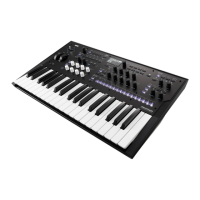Utility
77
Velocity curves
1 (Heavy), 2, 3: These are for heavy playing; most of the variation occurs in the upper velocity range.
4 (Normal): This is the default.
5, 6: These are for lighter playing.
7: This is for very light playing, at the expense of control in the middle of the range.
8 (Light): This curve produces the most uniform output, for when velocity sensitivity is not desired.
9 (Wide): This curve is designed for the heavier touch of external weighted keyboards.
Convert Position
[Pre-MIDI, Post-MIDI]
This setting controls how the Transpose and Velocity Curve settings work.You can think of these as a set of MIDI
effects processors, which can be used in one of two places within the wavestate.
Note: Regardless of the Convert Position, Transpose and Velocity Curve always apply when playing internal sounds
directly from the wavestate keyboard.
Pre-MIDI: This is the default. Transpose and Velocity Curve affect MIDI output.
Convert Position = Pre-MIDI
Post-MIDI: Transpose and Velocity Curve affect MIDI input. Use this to adjust response to an external MIDI
controller.
Post-MIDI also shifts Global and Performance Scales to match the Transpose setting—convenient for use with non-
equal-tempered scales. See also “Layer Transpose” on page 79.
1 127
1
8
6
5
4
3
2
7
127
1
1
2
3
8
6
5
4
7
9
9
Velocity (Keyboard to MIDI Out)
Convert Position = Pre-MIDI Convert Position = Post-MIDI
Velocity (MIDI In to sound engine)
Velocity
effect
Soft Strong
Max
MIDI In
MIDI Out
Velocity
Curve
Transpose
Note Number changes
Transmitted Received
Velocity
Curve = 4
No
Transpose
wavestate built-in keyboard
Scale
Tone
generator

